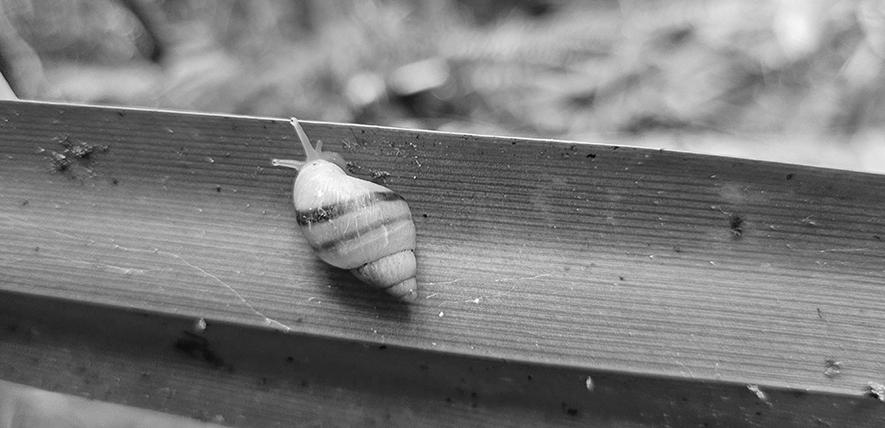
A global conservation effort to reintroduce a tiny snail to the wild is celebrating a momentous milestone: for the first time in 40 years, conservationists have found born-in-the-wild adult Partula tohiveana – meaning the precious molluscs have successfully established themselves in French Polynesia.
This year Cambridge’s Dr Justin Gerlach helped restore over 6,000 of the snails to Moorea, their French Polynesian island home as part of an annual reintroduction of zoo-bred ‘Extinct in the Wild’ and ‘Critically Endangered’ snail species – carried out through collaboration with zoos around the world.
During their work the team found unmarked Partula tohiveana: proof that previously reintroduced snails have successfully bred in the area.
The momentous discovery means Partula tohiveana can now be considered as established – an incredibly rewarding result for 40 years of dedication and collaboration. Conservationists will now begin the process of downlisting the snails from ‘Extinct-in-the-Wild’ to ‘Critically Endangered’ on the IUCN’s Red List.
Very few species have been reintroduced successfully having been completely extinct in the wild. This is also the very first invertebrate species where this has been achieved.
Ten species and sub-species of the tropical snails, reared at London Zoo, Bristol Zoological Society, Detroit Zoological Society, Marwell Wildlife, the Royal Zoological Society of Scotland, Saint Louis Zoo, Sedgwick County Zoo, Woodland Park Zoo and Zoo Schwerin, travelled more than 15,000km to Tahiti at the beginning of September. Before making the two-day journey to the islands of Tahiti, Moorea and Huahine, the incredibly rare snails, which each measure a tiny 1-2cm in length, were individually counted and marked with a dot of red UV reflective paint. The ‘snail varnish’ glows under UV torchlight, helping conservationists in the field to spot and monitor the nocturnal snails at night, when they’re most active.
London Zoo’s Senior Curator of Invertebrates, Paul Pearce-Kelly, who leads the Partula conservation programme, said: “Though little, these snails have great cultural, scientific and conservation value. Partula snails have always been part of Polynesia’s rich cultural heritage and play an important role in the ecological health of their forest habitats. They’ve also been studied for over a century for the insights they give into how species evolve in isolated environments. Most recently, they’re providing a valuable conservation model for helping hundreds of endangered island species.”
He added: “This collaborative conservation effort is playing a crucial role in saving these species from extinction. It’s a powerful example of how conservation zoos can combat biodiversity loss. At a time when nature faces unprecedented challenges, these small snails are a symbol of hope for global wildlife.”
Partula snails – also known as Polynesian tree snails – eat decaying plant tissue and fungi, so play an important role in maintaining forest health. Returning these rare snails back to the wild helps to restore the ecological balance in these islands.
Dr Justin Gerlach of Peterhouse, University of Cambridge and an Academic Associate at the University’s Museum of Zoology, said: “Discovering wild-born adult snails was a great moment. Very few animal species have been re-established back in the wild so this is a fantastic achievement for the programme – the fruit of a vast amount of work.”
Conservation zoos are working with the French Polynesian Government’s Direction de l’environnement, to save Partula snails from extinction. In the 1980s and early 1990s, these snails faced a critical threat after the invasive rosy wolf snail (Euglandina rosea) was introduced to control the African giant land snail (Lissachatina fulica). Unfortunately, the predatory species targeted the native snails instead, leading to the extinction or near-extinction of many Partula species across the region.
In the early 1990s, the last remaining individuals of several Partula species were rescued by London and Edinburgh Zoos, launching an international conservation breeding programme. This collaboration between 15 zoos cares for 15 species and subspecies, most of which are classified as ‘Extinct-in-the-Wild’. These rescued snails, along with those already being studied at universities in the UK and North America, became the foundation for reintroducing the species back onto their native island homes.
Paul said: “After decades of caring for these species in conservation zoos and working with the Direction de l’environnement to prepare the islands, we started reintroducing Partula snails back into their lowland tropical forests almost 10 years ago. Since then, we’ve reintroduced over 30,000 snails, including 10 Extinct-in-the-Wild species and subspecies, with this year’s release being the largest so far, thanks to our international team and collaborators, including mollusc specialist Dr Justin Gerlach of Peterhouse, University of Cambridge.”
London Zoo’s coordination of the Partula snail reintroduction project is made possible due to funding from supporters including the Players of the People’s Postcode Lottery, who have enabled London Zoo to continue bringing species back from the brink of extinction.
Adapted from a press release by the Zoological Society of London.
“The University of Cambridge is a public collegiate research university in Cambridge, England. Founded in 1209, the University of Cambridge is the third-oldest university in continuous operation.”
Please visit the firm link to site






